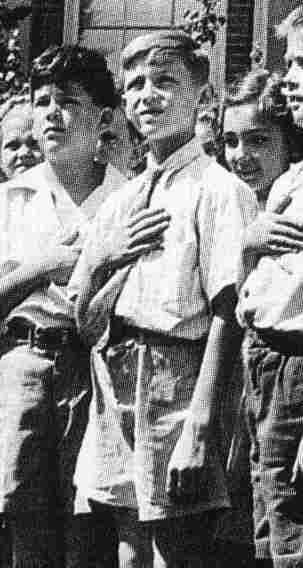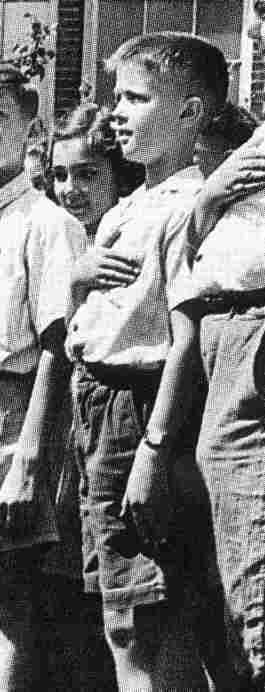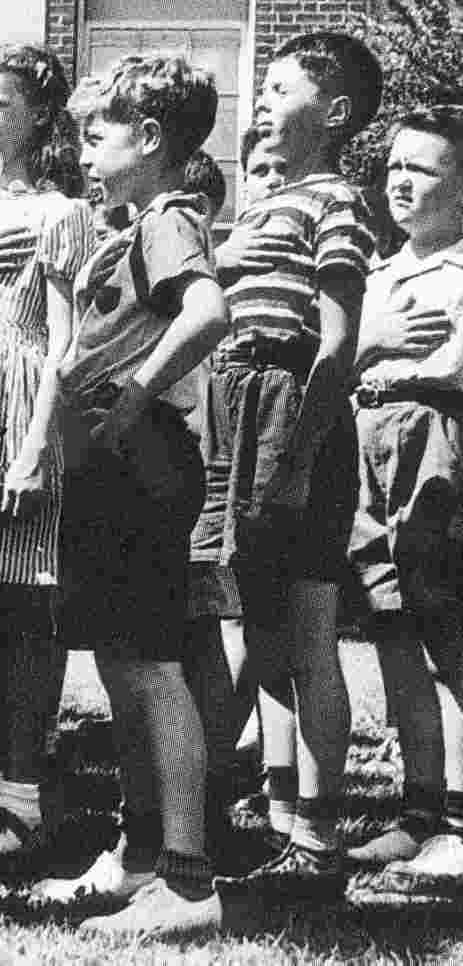
Figure 1.--This boy wore a tie to school to have his photograph taken. Him and the boy to his left are the only boys wearing ties. Click on the image for a view of the entire class.


Figure 1.--This boy wore a tie to school to have his photograph taken. Him and the boy to his left are the only boys wearing ties. Click on the image for a view of the entire class. |
The Japanese attack on Pear Harbor on December 7, 1941, brought America into World War II (1941-45). The massive reordering of the American economy initiated profound social and economic changes that are still unfolding today. Fashion was one of those changes. While the fashion industry was put on hold during the War, boys fashions changed considerably. Knickers which had begun to decline in populasrity during the late 1930s rapidly disappeared in the early 1940s. Aftervthe War the practical, casual clothing became the dominate styles for boys.
This photograph is not dated. HBC believes, however, that it was probably taken in the early or mid 1940s. The long baggy shorts the boys wear were more common in the early than the late 1940s. The fact that one boy is still wearing knickers also suggests the early 1940s.
I am not sure how popular that shorts were. It is interesting that all of the boys in this class wear short pants. Being a public school thaere would have been no school requirement. Apparently all these boys wore short pants as there everyday wear. Notably the older boy raising the flag wears long pants. Presumably many of these boys were looking forward to being able to wear longs.
Unlike the boys, none of the girls wear shorts or long pants. Girls in the 1940s still all wore dresses to school.

Figure 2.--This boy kije the other boys in his class wears short pants with short socks. The only exception is the boy wearing knickers. |
No details are available on the school pictured here. The children look tp be about 10tyears of age. That wuld mean that thery are probably 4th graders.
Most of the clothes appear to be made out of cotton. Notice how wrinkled many of the outfits were. This was before the modern wasy care materials had been marketed.
Most of the boys in this class wear similar shirts and all, except one, wear short pants. This similarity is unusual in a public school. An older boy, serving as a Saftey Patrol, who is probably a 6th grader (12 year old) raising the flag, wears long pants. One boy wears knickers. None of the boys wear kneesocks.
These children are all outdoors. However, it looks like they have previously arrived and come out to have their photographs taken. Thus it isd not clear if they wore caps and if so what kind.
The boys seem to be wearing light colored short sleeves shirts with collars. They are not wearing a "T" shirt unfer their shirts as it would be visible at the collar. Only two boys appear to be wearing a more casual "T" shirt. There were no logo "T" shirts in the 1940s. Rather most "T" shirts were bright horizontalm stripes.

Figure 3.--This boy wearing knickers was the only ione in his class not wearing short pants. Not that he is wearing short ankle socks with his knickers. |
Most of the boys wear comfortable-looking open necked casual shirts. Only one boy has dressed uop by wearing a tie.
Narly all the boys are wearing rather long short pants, in some cases quite baggy. The other styles of pants are also shown. One of the boys wears knickers which were clearly going out of style. I'm not sure what the boys thought of knickers. Some might have thought them more grown up as was the case in the 1930s. By the 1940s, however, may probably viewed them as old fashioned. The one older boy, pictured as raising the flag, wears long pants.
All of the boys are wearing short ankle socks. Not one boy wears kneesocks. This is in part because it is probably May or June and a little warm. Even so, if this photograoph had been taken in the 1930s, certainly some of the boys wiould have been wearing kneesoicks. By the 1940s, American boys were increasingly seeing kneesoicks as girlks or little boys clothes.
Most of the boys wear leather lace up shoes. Some of the boys wear white and colored sneakers.

Figure 4.--This is one of the two boys wearing stripped "T"-shirts. He alsi appears tonbe wearing colored sneakers. |
Wrist watches were worn by boys in the 1940s. Children's novelty watches with cartoon characters, the Mickey Mouse watch, had appeared in the 1930s. Even
so, it was relatively rare for boys to wear them. While they were not enormously expensive, they were not cheap. I'm not sure what age child that these novelty watches were aimed at or that they appealed to. Older elementary boys might not have wanted to wear novelty watches. Thus most boys did not wear them, even the novelty watches. Regular watches in boys sizes were also available, but even more expensive than the novely watches. Thus watches for boys were considered an unecessary extravagance for many families. This was especially true during the Depression era of the 1930s. It was only with the upsring in War production in 1939 and the 1940s that the Depression really ended.
Today, thanks to the mass media and merchandising/manufacturing, clothing styles
have become standardized throughout America--if not worldwide. Apart from
differences in clothing we might expect to see due to
variations in climate or relative affluence, regional or local variations began to
disappear after World War II. The population diclocations and the huge number of servicemen serving in the most remote corners of the globe exposed vast numbers of people to new and different cultures. In many cases it was American cuture that the world loked to. THis was magnified in the 1960s as virtually everyone around the world was exposed to merican television programming. Some Communist countries aired programs like Dallas to sress American decadence and found that their people were transfixed. (A good example is that Larry Hagman now touts Russion petroleum products. The Romanians remember him from Dallas.) The fashions that adults and women wore on American television thus had a huge impact on helping to create global fashions.
Navigate the Boys' Historical Clothing Web Site:
[Return to the Main U.S. 1940s elementary school page]
[Introduction]
[Art]
[Bibliographies]
[Biographies]
[Chronology]
[Clothing styles]
[Contributions]
[Countries]
[Boys' Clothing Home]
